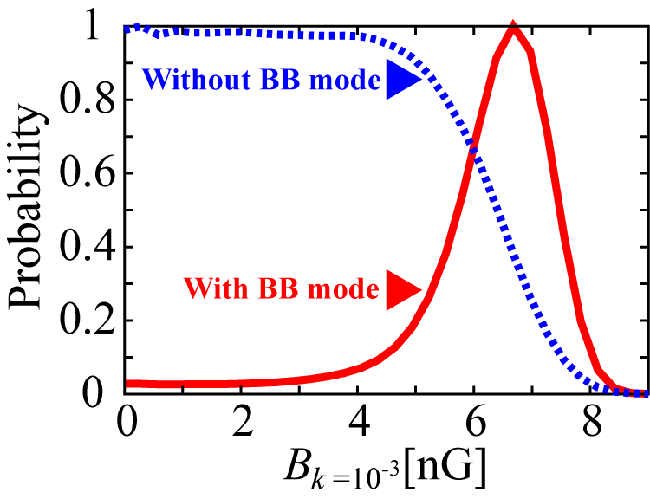Abstract
Authors
Details
|
New constraints on primordial magnetic fields from the CMB
Nov. 11. 13
 |
|
 |
Abstract
|
A Japanese research team led by
Dai G. Yamazaki (Division of Theoretical Astronomy, National Astronomical Observatory of Japan) has released a new constraints on the multi-lognormal magnetic fields from the observations of the cosmic microwave background and the matter power spectrum.
Primordial magnetic fields (PMFs), which were generated in the early universe before recombination, affect the motion of plasma and then the cosmic microwave background (CMB) and the matter power spectrum (MPS). We consider constraints on PMFs with a characteristic correlation length from the observations of the anisotropies of CMB (WMAP, QUAD, ACT, SPT, and ACBAR) and MPS. The spectrum of PMFs is modeled with multi-lognormal distributions (MLND), rather than power-law distribution, and we derive constraints on the strength |B ( k )| at each wavenumber k along with the standard cosmological parameters in the flat Universe and the foreground sources. We obtain upper bounds on the field strengths at
k = 10-1, -2, -4. -5 Mpc-1 as 4.7 nG, 2.1 nG, 5.3 nG and 10.9 nG (2σ C.L.) respectively, while the field strength at k = 10-3 Mpc-1 turns out to have a finite value as
|B ( k =10-3 Mpc-1 )| = 6.2 ± 1.3 nG (1σ C.L.).
This finite value is attributed to the finite values of BB mode data at l > 300 obtained from QUAD experiment. If we do not include the BB mode data, we obtain only the upper bound on |B ( k =10-3 Mpc-1 )|.
|
|
  |
 |
|
 |
Authors
|
|
|
  |
 |
|
 |
Details
|
|
From discoveries of magnetic fields in clusters of galaxies, many authors have studied cosmological magnetic fields.
The origins of primordial magnetic fields (PMFs) have been studied by many authors.
PMFs may manifest temselves in the temperature and polarization anisotropies of the cosmic microwave background (CMB), the large-scale structure, and other physical phenomena.
The effects of PMFs on physics in the early Universe and constraints on the PMFs from the cosmological observations are the well investigated topics.
A power law spectrum has often been considered for the study of PMFs in the literature, because it is expected for PMFs generated by inflation. On the other hand, causal processes such as bubble collisions during phase transition would generate PMFs with a characteristic scale. To study such PMFs, in our previous work, we considered PMFs with a log-normal distribution (LND), which is parametrized by the characteristic wavenumber k, the field strength at the wavenumber |B (k )| and the width σM of the spectrum.
We derived constraints on the parameters from the observations of the CMB and the matter power spectrum (MPS). This type of PMF spectrum is also useful to study which scale of PMFs mainly affect the CMB.
|
Parameters
|
Constraints
|
|
|B (k = 10-1Mpc-1)|
|
< 4.7 nG (95 % C.L.)
|
|
|B (k = 10-2Mpc-1)|
|
< 2.1 nG (95 % C.L.)
|
|
|B (k = 10-3Mpc-1)|
|
6.2 ± 1.3 nG (68 % C.L.)
|
|
|B (k = 10-4Mpc-1)|
|
< 5.3 nG (95 % C.L.)
|
|
|B (k = 10-5Mpc-1)|
|
< 10.9 nG (95 % C.L.)
|
|
|
Table 1:
Confidence intervals (1σ) and upper bounds (2σ) on strengths of PMFs.
|

|
|
Fig. 1;
Probability distributions of the PMF strengths at k = 10-3 Mpc-1 from the CMB and the MPS data with the BB mode (solid) and without (dotted).
|
Our MCMC algorithm is performed until all of the cosmological parameters including the PMF strengths are well converged.
We find that the minimum total χ2 improves from 12563.2 to 12554.9 by introducing the PMFs.
This improvement mainly comes from the finite B mode spectrum at k =10-3 Mpc-1.
For the strengths except the one at k =10-3 Mpc-1, upper bounds are obtained at $2\sigma$ as Table 1.
On the other hand, for the strength at k=10-3 Mpc-1, non-zero value is favored at more than 2.5σ as Table 1
Fig. 1 also shows the probability distribution functions of PMF strengths at k=10-3 Mpc-1 obtained by our MCMC analysis.
In Fig. 1, the probability distribution functions obtained without CMB BB modes (curl-type polarization fluctuations) are also shown. We can see, in this case, the lower bound of the PMF strength at k=10-3 Mpc-1 disappears. Thus, the non-zero value is favored by the BB mode data.
Since the current BB mode data have relatively large errors, we must wait for the future observations to obtain more robust conclusion. The non-gaussianity in the fluctuations is another way to identify the PMFs. The prediction of non-gaussianity generated by the PMF indicated in this paper will be presented elsewhere in near future.
|
|
  |
|
|
|

